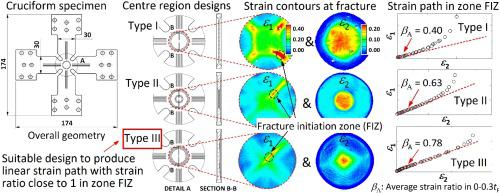当前位置:
X-MOL 学术
›
J. Mater. Process. Tech.
›
论文详情
Our official English website, www.x-mol.net, welcomes your
feedback! (Note: you will need to create a separate account there.)
Effect of cruciform specimen design on strain paths and fracture location in equi-biaxial tension
Journal of Materials Processing Technology ( IF 6.7 ) Pub Date : 2021-03-01 , DOI: 10.1016/j.jmatprotec.2020.116932 Ruiqiang Zhang , Zhutao Shao , Zhusheng Shi , Trevor A. Dean , Jianguo Lin
Journal of Materials Processing Technology ( IF 6.7 ) Pub Date : 2021-03-01 , DOI: 10.1016/j.jmatprotec.2020.116932 Ruiqiang Zhang , Zhutao Shao , Zhusheng Shi , Trevor A. Dean , Jianguo Lin

|
Abstract Hot stamping technologies require new methods for evaluating formability of sheet metal under various forming conditions. Biaxial tensile testing method using a cruciform specimen has been used for the applications, but a suitable cruciform specimen design has not yet been accepted. One of the challenges in designing a specimen for formability tests is to ensure proportional equi-biaxial strain paths arise at the location of fracture initiation. In this study, after reviewing existing cruciform specimen designs, three different geometries of cruciform specimen, named Type I, Type II and Type III, were proposed. Using numerical analysis and practical experiments, fracture initiation locations and corresponding strain paths in the specimens were investigated under equi-biaxial tension. Numerical simulations were performed to optimise the dimensions of Type I specimen to achieve a relatively high strain level near the centre point of the specimen. Based on the optimised dimensions, equi-biaxial tensile tests were carried out on cruciform specimens with different geometries, and strain paths at the fracture initiation locations were compared and analysed. It was found that in all cruciform specimens, equi-biaxial strain state appears only near the centre point. In the Type I and Type II specimens, fracture never initiates near the centre point, but at a location in the fillet transition zone where major strain is higher than that at the centre point. The Type III specimens have the ability to initiate fracture near the centre point, and to produce proportional strain paths with strain ratio β close to 1 in equi-biaxial tension, 0 in plane-strain tension, and -0.5 in uniaxial tension at the locations of fracture initiation. The research provides a cruciform specimen design, Type III, which has high potential to be used for evaluating formability for sheet metal.
中文翻译:

十字形试样设计对等双轴拉伸应变路径和断裂位置的影响
摘要 热冲压技术需要新的方法来评估各种成形条件下金属板的成形性。使用十字形试样的双轴拉伸试验方法已被用于应用,但尚未接受合适的十字形试样设计。设计用于可成形性测试的试样的挑战之一是确保在断裂起始位置出现成比例的等双轴应变路径。在这项研究中,在审查了现有的十字形试样设计后,提出了三种不同几何形状的十字形试样,称为 I 型、II 型和 III 型。通过数值分析和实际实验,研究了等双轴拉伸下试样的断裂起始位置和相应的应变路径。进行数值模拟以优化 I 型试样的尺寸,以在试样中心点附近实现相对较高的应变水平。在优化尺寸的基础上,对不同几何形状的十字形试样进行等双轴拉伸试验,对比分析了断裂起始位置的应变路径。发现在所有十字形试样中,等双轴应变状态仅出现在中心点附近。在 I 型和 II 型试样中,断裂永远不会在中心点附近开始,而是在圆角过渡区中主要应变高于中心点的位置处开始。III 型试样能够在中心点附近开始断裂,并在等双轴拉伸中产生应变比 β 接近 1 的成比例应变路径,0 在平面应变张力,和-0.5 在断裂起始位置的单轴张力。该研究提供了一种十字形试样设计,即 III 型,它具有用于评估金属板可成形性的巨大潜力。
更新日期:2021-03-01
中文翻译:

十字形试样设计对等双轴拉伸应变路径和断裂位置的影响
摘要 热冲压技术需要新的方法来评估各种成形条件下金属板的成形性。使用十字形试样的双轴拉伸试验方法已被用于应用,但尚未接受合适的十字形试样设计。设计用于可成形性测试的试样的挑战之一是确保在断裂起始位置出现成比例的等双轴应变路径。在这项研究中,在审查了现有的十字形试样设计后,提出了三种不同几何形状的十字形试样,称为 I 型、II 型和 III 型。通过数值分析和实际实验,研究了等双轴拉伸下试样的断裂起始位置和相应的应变路径。进行数值模拟以优化 I 型试样的尺寸,以在试样中心点附近实现相对较高的应变水平。在优化尺寸的基础上,对不同几何形状的十字形试样进行等双轴拉伸试验,对比分析了断裂起始位置的应变路径。发现在所有十字形试样中,等双轴应变状态仅出现在中心点附近。在 I 型和 II 型试样中,断裂永远不会在中心点附近开始,而是在圆角过渡区中主要应变高于中心点的位置处开始。III 型试样能够在中心点附近开始断裂,并在等双轴拉伸中产生应变比 β 接近 1 的成比例应变路径,0 在平面应变张力,和-0.5 在断裂起始位置的单轴张力。该研究提供了一种十字形试样设计,即 III 型,它具有用于评估金属板可成形性的巨大潜力。











































 京公网安备 11010802027423号
京公网安备 11010802027423号